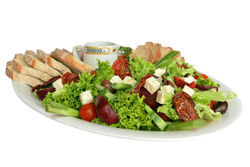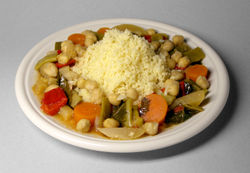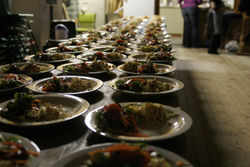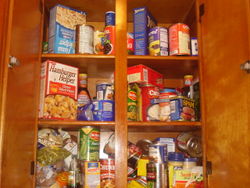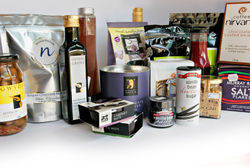Food
2007 Schools Wikipedia Selection. Related subjects: Food and agriculture
Food is any substance, usually comprised primarily of carbohydrates, fats, water and/or proteins, that can be eaten or drunk by animals (including humans) for nutrition and/or pleasure.
cian was here:)!!! Most cultures have a recognizable cuisine: a specific set of cooking traditions, preferences, and practices, the study of which is known as gastronomy. The study of food is called food science. In English, the term food is often used metaphorically or figuratively, as in food for thought.
Legal definition
English-speaking countries usually define four categories of substances as food :
- any substance, intended to be, or reasonably expected to be, ingested by humans;
- water and other drinks;
- chewing gum;
- substances used as ingredients in the preparation of food.
Food production
Food is traditionally obtained through farming, ranching, and fishing, with hunting, foraging and other methods of subsistence locally important. More recently, there has been a growing trend towards more Sustainable agricultural practices. This approach - which is partly fuelled by consumer demand - encourages biodiversity, local self-reliance and Organic farming methods.
Major influences on food production are international policy, (e.g. the World Trade Organization and Common Agricultural Policy), national government policy (or law), and war.
Food for livestock is fodder and traditionally comprises hay or grain.
Food preparation
While some food can be eaten without preparation, many foods undergo some form of preparation for reasons of safety, palatability, or flavor. At the simplest level this may involve washing, cutting, trimming or adding other foods or ingredients, such as spices. It may also involve mixing, heating or cooling, pressure cooking, fermentation, or combination with other food.
In a home, most food preparation takes place in a kitchen. Some preparation is done to enhance the taste or aesthetic appeal; other preparation may help to preserve the food; and others may be involved in cultural identity. A meal is made up of food which is prepared to be eaten at a specific time and place.
The preparation of animal-based food will usually involve slaughter, evisceration, hanging, portioning and rendering.
Cooking
The term "cooking" encompasses a vast range of methods, tools and combinations of ingredients to improve the flavour or digestibility of food. It generally requires the selection, measurement and combining of ingredients in an ordered procedure in an effort to achieve the desired result. Constraints on success include the variability of ingredients, ambient conditions, tools, and the skill of the individual cooking.
The diversity of cooking worldwide is a reflection of the myriad nutritional, aesthetic, agricultural, economic, cultural and religious considerations that impact upon it.
Cooking requires applying heat to a food which usually, though not always, chemically transforms it, thus changing its flavor, texture, appearance, and nutritional properties. Cooking proper, as opposed to roasting, requires the boiling of water in a receptable, and was practiced at least since the 10th millennium BC with the introduction of pottery. There is archaeological evidence of roasted foodstuffs at Homo erectus campsites dating from 420,000 years ago.
Food manufacture
Packaged foods are manufactured outside the home for purchase. This can be as simple as a butcher preparing meat, or as complex as a modern international food industry.
Early food processing techniques were limited by available food preservation, packaging and transportation. This mainly involved salting, curing, curdling, drying, pickling and smoking.
During the industrialisation era in the 19th century, food manufacturing arose. This development took advantage of new mass markets and emerging new technology, such as milling, preservation, packaging and labelling and transportation. It brought the advantages of pre-prepared time saving food to the bulk of ordinary people who did not employ domestic servants.
At the start of the 21st century, a two-tier structure has arisen, with a few international food processing giants controlling a wide range of well known food brands. There also exists a wide array of small local or national food processing companies. Advanced technologies have also come to change food manufacture. Computer-based control systems, sophisticated processing and packaging methods, and logistics and distribution advances, can enhance product quality, improve food safety, and reduce costs.
Food trade
Food is now traded on a global basis. The variety and availability of food is no longer restricted by the diversity of locally grown food or the limitations of the local growing season. Between 1961 and 1999 there has been a 400% increase in worldwide food exports. Some countries are now economically dependent on food exports, which in some cases account for over 80% of all exports.
In 1994 over 100 countries became signatories to the Uruguay Round of the General Agreement on Tariffs and Trade in a dramatic increase in trade liberalisation. This included an agreement to reduce subsidies paid to farmers, underpinned by the WTO enforcement of agricultural subsidy, tariffs, import quotas and settlement of trade disputes that cannot be bilaterally resolved. Where trade barriers are raised on the disputed grounds of public health and safety, the WTO refer the dispute to the Codex Alimentarius Commission, which was founded in 1962 by the United Nations Food and Agriculture Organization and the World Health Organization. This has greatly affected world food trade.
Food retailing
In the pre-modern era, the sale of surplus food took place once a week when farmers took their wares on market day, into the local village market place. Here food was sold to grocers for sale in their local shops for purchase by local consumers.
With the onset of industrialisation, and the development of the food processing industry, a wider range of food could be sold and distributed in distant locations. Typically early grocery shops would be counter-based shops, in which purchasers told the shop-keeper what they wanted, so that the shop-keeper could get it for them.
In the 20th century supermarkets were born. Supermarkets brought with them a self service approach to shopping using shopping carts, and were able to offer quality food at lower cost through economies of scale and reduced staffing costs. In the latter part of the 20th century, this has been further revolutionised by the development of vast warehouse-sized out-of-town supermarkets, selling a wide range of food from around the world.
Unlike food processors, food retailing is a two-tier market in which a small number of very large companies control a large proportion of supermarkets. The supermarket giants wield great purchasing power over farmers and processors, and strong influence over consumers. Nevertheless, less than ten percent of consumer spending on food goes to farmers, with larger percentages going to advertising, transportation, and intermediate corporations.
Famine and hunger
Food deprivation leads to malnutrition and ultimately starvation. This is often connected with famine, which involves the absence of food in entire communities. This can have a devastating and widespread effect on human health and mortality. Rationing is sometimes used to distribute food in times of shortage, most notably during times of war.
Starvation is a significant international problem. Approximately 815 million people are undernourished, and over 16,000 children die per day from hunger-related causes. Besides starvation, insufficient food causes nearly a third of all babies born worldwide to die prematurely or have disabilities. Food deprivation is regarded as a deficit need in Maslow's hierarchy of needs and is measured using famine scales.
Food aid
Food aid can benefit people suffering from a shortage of food. It can be used to improve peoples' lives in the short term, so that a society can increase its standard of living to the point that food aid is no longe required. Conversely, badly managed food aid can create problems by disrupting local markets, depressing crop prices, and discouraging food production. Sometimes a cycle of food aid dependence can develop. Its provision, or threatened withdrawal, is sometimes used as a political tool to influence the politics of the destination country. Sometimes, also, food aid provisions will require certain types of food be purchased from certain sellers, and food aid can be misused to enhance the markets of donor countries. International efforts to distribute food to the neediest countries are often co-ordinated by the World Food Programme.
Food safety
Foodborne illness, commonly called "food poisoning," is caused by bacteria, toxins, viruses, parasites, and prions. Roughly 7 million people die of food poisoning each year, with about 10 times as many suffering from a non-fatal version.
The two most common factors leading to cases of bacterial foodborne illness are cross-contamination of ready-to-eat food from other uncooked foods and improper temperature control. Less commonly, acute adverse reactions can also occur if chemical contamination of food occurs, for example from improper storage, or use of non-food grade soaps and disinfectants. Food can also be adulterated by a very wide range of articles (known as 'foreign bodies') during farming, manufacture, cooking, packaging, distribution or sale. These foreign bodies can include pests or their droppings, hairs, cigarette butts, wood chips, and all manner of other contaminants. It is possible for certain types of food to become contaminated if stored or presented in an unsafe container, such as a ceramic pot with lead-based glaze.
Food poisoning has been recognised as a disease of man since as early as Hippocrates. The sale of rancid, contaminated or adulterated food was commonplace until introduction of hygiene, refrigeration, and vermin controls in the 19th century. Discovery of techniques for killing bacteria using heat and other microbiological studies by scientists such as Louis Pasteur contributed to the modern sanitation standards that we enjoy today. This was further underpinned by the work of Justus von Liebig whose work led to the development of modern food storage and food preservation methods. In more recent years, a greater understanding of the causes of food-borne illnesses has led to the development of more systematic approaches such as HACCP, which can identify and eliminate many risks.
Food allergies
Some people have allergies or sensitivities to foods which are not problematic to most people. This occurs when a person's immune system mistakes a certain food protein for a harmful foreign agent and attacks it. About 2% of adults and 8% of children have a food allergy. The amount of the food substance required to provoke a reaction in a susceptible individual can be minute. For instance, tiny amounts of food in the air, too minute to be smelled, have been known to provoke lethal reactions in sufficiently sensitive individuals. Commonly food allergens are gluten, corn, shellfish (mollusks), peanuts, and soy. Most patients present with diarrhea after ingesting certain foodstuffs, skin symptoms ( rashes), bloating, vomiting and regurgitation. The digestive complaints usually develop within half an hour of ingesting the allergen.
Rarely, food allergy can lead to anaphylactic shock: hypotension (low blood pressure) and loss of consciousness. This is a medical emergency. An allergen associated with this type of reaction is peanut, although latex products can induce similar reactions. Initial treatment is with epinephrine (adrenaline), often carried by known patients in the form of an Epi-pen.
Dietary habits
Dietary habits are the habitual decisions an individual or culture makes when choosing what foods to eat. Although humans are omnivores,or who eats all the time. each culture holds some food preferences and some food taboos. Dietary choices can also define cultures and play a role in religion. For example, only Kosher foods are permitted by Judaism, and Halal/Haram foods by Islam, in the diet of believers. In addition, the dietary choices of different countries or regions have different characteristics. This is highly related to a culture's cuisine.
Dietary habits play a significant role in the health and mortality of all humans. Imbalances between the consumed fuels and expended energy results in either starvation or excessive reserves of adipose tissue, known as body fat. Poor intake of various vitamins and minerals can lead to diseases which can have far-reaching effects on health. For instance, 30% of the world's population either has, or is at risk for developing, Iodine deficiency. It is estimated that at least 3 million children are blind due to vitamin A deficiency. Vitamin C deficiency results in scurvy. Calcium, Vitamin D and Phosphorus are inter-related; the consumption of each may affect the absorption of the others. Kwashiorkor and marasmus are childhood disorders caused by lack of dietary protein. Obesity, a serious problem in the western world, leads to higher chances of developing heart disease, diabetes, and many other diseases.
Many individuals choose to limit what foods the eat for reasons of health, morality, or other factors. For instance vegetarians choose to forgo food from animal sources to varying degrees. Others choose a healthier diet, avoiding sugars or animal fats and increasing consumption of dietary fibre and antioxidants.
More recently, dietary habits have been influenced by the concerns that some people have about possible impacts on health or the environment from genetically modified food. Further concerns about the impact of industrial farming on animal welfare, human health and the environment are also having an effect on contemporary human dietary habits. This has led to the emergence of a counterculture with a preference for organic and local food.
Nutrients in food
Between the extremes of optimal health and death from starvation or malnutrition, there is an array of disease states that can be caused or alleviated by changes in diet. Deficiencies, excesses and imbalances in diet can produce negative impacts on health, which may lead to diseases such as scurvy, obesity or osteoporosis, as well as psychological and behavioural problems. The science of nutrition attempts to understand how and why specific dietary aspects influence health.
Nutrients in food are grouped into several categories. Macronutrients means fat, protein, and carbohydrates. Micronutrients are the minerals and vitamins. Additionally food contains water and dietary fibre.
